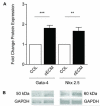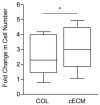A naturally derived cardiac extracellular matrix enhances cardiac progenitor cell behavior in vitro
- PMID: 22842035
- PMCID: PMC3488121
- DOI: 10.1016/j.actbio.2012.07.033
A naturally derived cardiac extracellular matrix enhances cardiac progenitor cell behavior in vitro
Abstract
Myocardial infarction (MI) produces a collagen scar, altering the local microenvironment and impeding cardiac function. Cell therapy is a promising therapeutic option to replace the billions of myocytes lost following MI. Despite early successes, chronic function remains impaired and is likely a result of poor cellular retention, proliferation, and differentiation/maturation. While some efforts to deliver cells with scaffolds have attempted to address these shortcomings, they lack the natural cues required for optimal cell function. The goal of this study was to determine whether a naturally derived cardiac extracellular matrix (cECM) could enhance cardiac progenitor cell (CPC) function in vitro. CPCs were isolated via magnetic sorting of c-kit(+) cells and were grown on plates coated with either cECM or collagen I (Col). Our results show an increase in early cardiomyocyte markers on cECM compared with Col, as well as corresponding protein expression at a later time. CPCs show stronger serum-induced proliferation on cECM compared with Col, as well as increased resistance to apoptosis following serum starvation. Finally, a microfluidic adhesion assay demonstrated stronger adhesion of CPCs to cECM compared with Col. These data suggest that cECM may be optimal for CPC therapeutic delivery, as well as providing potential mechanisms to overcome the shortcomings of naked cell therapy.
Copyright © 2012 Acta Materialia Inc. Published by Elsevier Ltd. All rights reserved.
Figures






Similar articles
-
Elastic, silk-cardiac extracellular matrix hydrogels exhibit time-dependent stiffening that modulates cardiac fibroblast response.J Biomed Mater Res A. 2016 Dec;104(12):3058-3072. doi: 10.1002/jbm.a.35850. Epub 2016 Aug 11. J Biomed Mater Res A. 2016. PMID: 27480328 Free PMC article.
-
Construction of scaffolds composed of acellular cardiac extracellular matrix for myocardial tissue engineering.Biologicals. 2018 May;53:10-18. doi: 10.1016/j.biologicals.2018.03.005. Epub 2018 Apr 3. Biologicals. 2018. PMID: 29625872
-
Platelet-Derived Growth Factor Receptor-Alpha Expressing Cardiac Progenitor Cells Can Be Derived from Previously Cryopreserved Human Heart Samples.Stem Cells Dev. 2018 Feb 1;27(3):184-198. doi: 10.1089/scd.2017.0082. Epub 2018 Jan 16. Stem Cells Dev. 2018. PMID: 29205098
-
Generation of induced cardiac progenitor cells via somatic reprogramming.Oncotarget. 2017 Apr 25;8(17):29442-29457. doi: 10.18632/oncotarget.15272. Oncotarget. 2017. PMID: 28199972 Free PMC article. Review.
-
Cardiac Extracellular Matrix Modification as a Therapeutic Approach.Adv Exp Med Biol. 2018;1098:131-150. doi: 10.1007/978-3-319-97421-7_7. Adv Exp Med Biol. 2018. PMID: 30238369 Free PMC article. Review.
Cited by
-
Endogenous Optical Signals Reveal Changes of Elastin and Collagen Organization During Differentiation of Mouse Embryonic Stem Cells.Tissue Eng Part C Methods. 2015 Oct;21(10):995-1004. doi: 10.1089/ten.TEC.2014.0699. Epub 2015 Jun 17. Tissue Eng Part C Methods. 2015. PMID: 25923353 Free PMC article.
-
Extracellular matrix remodeling following myocardial infarction influences the therapeutic potential of mesenchymal stem cells.Stem Cell Res Ther. 2014 Jan 24;5(1):14. doi: 10.1186/scrt403. Stem Cell Res Ther. 2014. PMID: 24460869 Free PMC article.
-
Amniotic fluid-derived stem cells demonstrated cardiogenic potential in indirect co-culture with human cardiac cells.Ann Biomed Eng. 2014 Dec;42(12):2490-500. doi: 10.1007/s10439-014-1114-5. Epub 2014 Sep 30. Ann Biomed Eng. 2014. PMID: 25266932 Free PMC article.
-
Stem Cell Imaging: Tools to Improve Cell Delivery and Viability.Stem Cells Int. 2016;2016:9240652. doi: 10.1155/2016/9240652. Epub 2016 Jan 6. Stem Cells Int. 2016. PMID: 26880997 Free PMC article. Review.
-
Development and characterization of a naturally derived lung extracellular matrix hydrogel.J Biomed Mater Res A. 2016 Aug;104(8):1922-35. doi: 10.1002/jbm.a.35726. Epub 2016 Apr 6. J Biomed Mater Res A. 2016. PMID: 27012815 Free PMC article.
References
-
- Olivetti G, Capasso JM, Meggs LG, Sonnenblick EH, Anversa P. Cellular basis of chronic ventricular remodeling after myocardial infarction in rats. Circ Res. 1991;68:856–69. - PubMed
-
- Swynghedauw B. Molecular mechanisms of myocardial remodeling. Physiol Rev. 1999;79:215–62. - PubMed
-
- Wang QD, Pernow J, Sjoquist PO, Ryden L. Pharmacological possibilities for protection against myocardial reperfusion injury. Cardiovasc Res. 2002;55:25–37. - PubMed
-
- Berry MF, Engler AJ, Woo YJ, Pirolli TJ, Bish LT, Jayasankar V, Morine KJ, et al. Mesenchymal stem cell injection after myocardial infarction improves myocardial compliance. Am J Physiol Heart Circ Physiol. 2006;290:H2196–203. - PubMed
Publication types
MeSH terms
Substances
Grants and funding
LinkOut - more resources
Full Text Sources
Other Literature Sources

